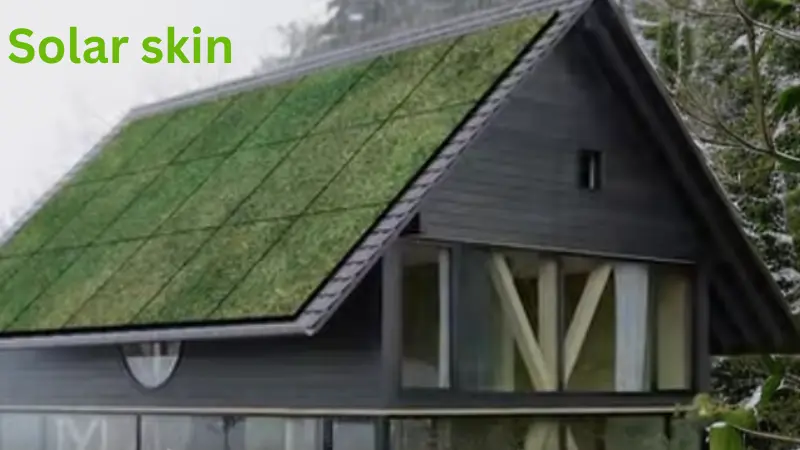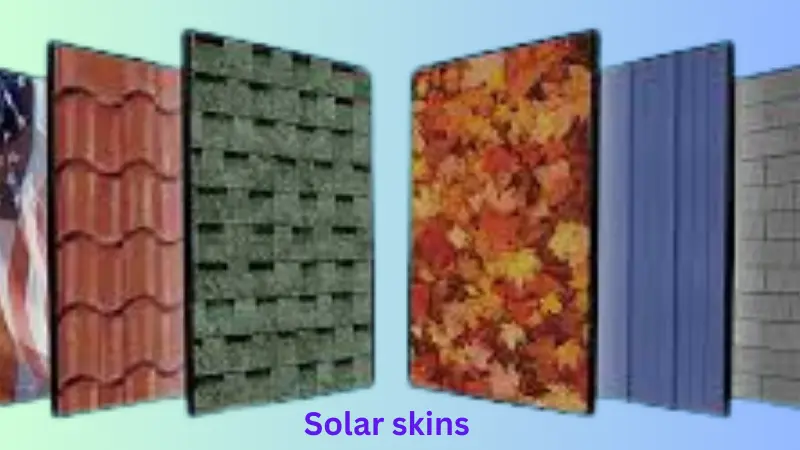Discover Solar Skins: The Ultimate Guide for Eco-Conscious Homeowners
Updated: 07 Sep 2024
49
Conventional modules of solar energy that are available in the market do work efficiently, but some of them may not blend well with the outlook of a building, making some homeowners very reluctant to use solar energy. This is where solar skin comes in, the solution to solar integration that looks different from a solution to such an integration. In this article, we will look at how solar skin is applied, its benefits, and how it addresses the problem of the dichotomy between beauty and functionality.

What are Solar Skins?
Solar skins are an innovation that aims to increase the beauty of solar panels while giving maximum efficiency. In other words, solar skins are mobile device overlays that can be applied on the surface of a solar power plant. These skins enable the panels to be concealed by showing images, patterns, or colors that match the roof or the surroundings of the place they are fixed on.
The essence of this technology is in the materials that make up the solar skins and filmmakers opted for the most transparent ones to sunlight. This transparency enables the solar cells below the skin to continue producing electrical energy as required. Solar skins are quite common among homeowners who wish to retain the house’s aesthetic value while going solar.
This has provided a solution for people who were indifferent to the aesthetics of normal solar panels, hence making solar energy more viable to most people. Through beauty and practicality, solar skins are a giant leap in integrating solar energy into the lives of advanced citizens.
Benefits of Solar Skins
As we have seen, even with all the described disadvantages solar skins are valuable for residential and commercial solar systems.
Aesthetic Integration
Indeed, it is possible to point out one of the main benefits that can be inferred concerning solar skins: the panels are integrated into the environment. In cases where one wants to have panels in the same color as the roof or to paint a picture of personal desire, Solar skins make it possible to keep the look of one’s building while making solar systems desirable.
Customization
Yes, Solarskin can be designed in a manner that would make them come with designs that people would want or even come with logos of different companies among them. This makes it possible to use them in integration into various architectural structures without putting too much strain on the outlook of that structure.
Maintained Efficiency
They preserve their apparent features, to these solar skins, vehicles or façades have to be mostly permeable to sunlight mainly in the surface plane. What this implies is that the various layers of the material that make up the basic solar cells can still do the conversion of sunlight to electricity and therefore the conductivity of the energy skin does not compromise how the electricity is manufactured from the sunlight by the module.
Increased Property Value
The beauty of the solar installation works can make the outlook of property appealing and this will add value to the property both economically and in outlook. Good-looking homes with appropriate installation of solar systems are on average more appealing to buyers who have the desire to conserve the environment and appropriate installation of solar systems.
Community Acceptance
For some cultures, the appearance of solar panels is an issue as such there is opposition to the placing of solar plants. Solar skins do this on the premise of beauty as citizens receive the clean energy they require while still maintaining the appearance of their locality.
Branding Opportunities:
To the brand manufacturers, solar skins create an opportunity for branding the solar panels while at the same time fulfilling their task. Companies can use the solar panels for advertisement and brand their logo and trademarks on the solar panels as they provide clean electricity.
Solar skins meet both the functional and aesthetic needs of people, thereby increasing the people’s ability to embrace the energy from solar, hence changing the trend towards a green energy solution.
Aesthetic Integration
One of the major benefits of solar skins is aesthetic integration where solar panels are incorporated into a surrounding and they are almost invisible. Whether it is a matching roof color, pattern, or custom design, solar skins allow for aesthetics to be achieved in that a home or building is beautified rather than marred by solar installation. This makes solar energy adoption more appealing for homeowners and business people who would otherwise consider the aesthetics of their compound in seeking to adopt the renewable energy source.
Functionality Preserved
Solar skins retain all the features of solar panels and improve the exterior look of the object for which they are installed. To achieve the extent of thinness and unobtrusiveness of skins, they have to be specially designed to transmit light, so that energy generation is not affected. Hence, this innovation is producing houses that have curb appeal and high-performance solar energy that do not deter the other.
Flexible Application
Some of the application forms of solar skins are inclusive of the following; Whichever the kind, be it mounted on rooftops, on the ground, or shaped in funny forms, fitted skin for solar panels may merge with them much more easily. This makes it possible for a homeowner to obtain a system that fits his or her house irrespective of the specific architectural or spatial concepts of the house.
What measures of solar skin impact the effectiveness of solar panels?

The solar skins are designed with selective light filtration and as such, most of the lights sourced are filtered to the solar cells. This helps the panels to retain their efficiency and at the same time, the outer surface of the panels has attractive prints or images. The conception of an extra layer may cause a certain fall in energy production but the best solar skins are designed in a way of preventing such effects and in most cases, the loss of effectiveness is less than one percent. The trade-off between the appearance of the solar skins and the effectiveness of the solar panels is fairly slight, so the installation of solar skins is a good choice for homeowners who wish to integrate their solar panels into the existing environment but do not wish to sacrifice profit.
Solar Skins Pros and Cons
| Pros of Solar Skins |
|---|
|
Aesthetic Appeal Solar skins are practical and visually pleasing, and the name suggests that they fit different styles of buildings successfully. These changeable skins can replicate the look of roofs landscapes or other motifs to blend the solar installation perfectly with the property. This makes solar skins a perfect choice for homeowners who intend to achieve consistency in their outlook. Increased Adoption With the advancement in the use of solar skins, there has been more use in the buildings of the homeowners as well as the business people. More people now require concepts that give both sustainable and aesthetic options, solar skins come into the picture offering exactly that. This increase in adoption is also being enhanced by technology that makes solar skins more efficient and affordable and thus encourages the use of renewable sources of energy. Increased Adoption It is for this reason that solar skins are increasingly being adopted because they enable the integration of solar technology with the design aspect. As people learn more about renewable resources, many homeowners and business people invest in solar skins to give their property a nice outlook while at the same time generating clean energy. This trend is the same as other similar emerging trends that have embraced green solutions that are not constrained by style. Customization Solar skins are flexible and can be designed in a way that the user desires or even by the d_cor of the area where the structures will be installed. Solar skins can be set up to mimic the appearance of a roof tiling, match the environment, or show a certain pattern, thus being versatile when it comes to appearance. This particular customization makes solar installations very effective in serving their purpose while at the same time satisfying different people’s tastes in design. Durability Solar skins are such that they should be robust enough to bear all sorts of incidences of climatic challenges without affecting the solar panels. Cut from durable materials, these skins do not fade, peel, or wear in any other way that is possible within some time. Their durability guarantees the function of aesthetics and protection relevant to the durability of both the solar skin and the solar panels that are underneath the skins. Minimal Efficiency Loss Solar skins are designed in a way that the efficiency of a solar skin is not huge compared to the underlying solar panels that are in use. These skins are made possible by the most recent light filtration technology that lets in most of the sunlight while at the same time providing the look of the skins. Therefore, the decrease in energy is almost negligible the implication being that solar skins can complement those who desire both performance and aesthetics. |
| Cons of Solar Skins |
|---|
|
Cost Implication The cost implication of the installation of solar skin depends on several factors such as the size of the solar skin, its design, and the manufacturer of the solar skin. Compared to traditional solar panels, solar skins do come at an extra cost, but most people are willing to pay the price because of the beauty of their new skins and the possibility of having their homes’ property prices boosted. However, since PEBs cost more than conventional buildings initially, then long-term advantages plus enhanced aesthetics may make the extra costs worthwhile for those ‘frugal between utility and style’. Slight Efficiency Reduction While solar skins ultimately also bring an aesthetic value, they seem to perform with slightly worse efficiency than a traditional panel. This reduction is generally small, normally it ranges between 2% and 5%, dependent on the design as well as the quality of the solar skin. However, this is a very small compromise, which most users are willing to make because they appreciate what the solar skins offer them in terms of design, color, and texture that allows them to easily incorporate the solar energy systems into their homes. Maintenance Considerations In general, solar skins are less likely to require a lot of maintenance compared to some of the metal and plastic skins available for boats, but some things should be remembered. It is imperative to clean them to avoid accumulation of debris which will affect the functions of the basal solar panels. To some extent the skins themselves are resistant to weather and wear and tear, however, it is advisable to check them for some signs of damage from time to time. Solar skin cleaning and checks are important in maintaining the looks and performance of the photovoltaic skin for the solar energy system to be effective. Limited Availability Solar skins, although not mainstream, have their problems where the product’s availability is poor. Due to the specialization of the parts, they are not quite as ubiquitous as standard solar panels. The limited distribution can be a result of factors for example production capabilities, and geographical location. Therefore, the homeowner may find the choices of the solar skin products limited and may be required to approach certain suppliers or installers, who offer such a sophisticated product. |
Conclusion
Solar skin technology turns solar panels into a functional art that can be easily incorporated into homeowners’ homes. This is because solar skin refashions solar panels that resemble roofing materials or designs; therefore, it increases the aesthetic value while retaining the functionality. This technology is a big leap toward the use of this renewable energy source because most homeowners who want to switch to renewable energy are hindered by aesthetics.
Please Write Your Comments